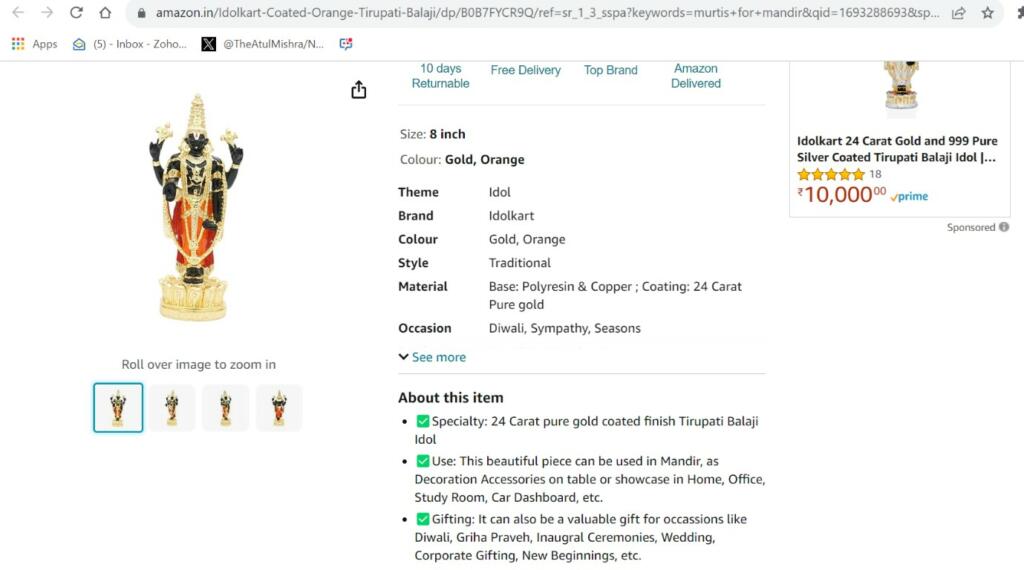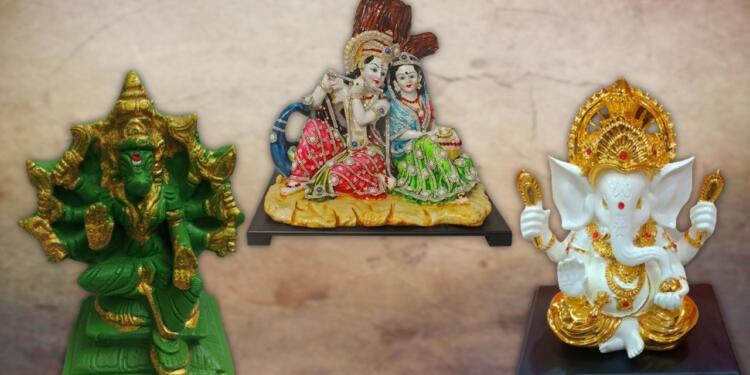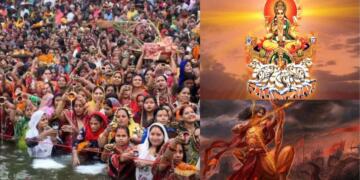Sanatana Dharma, our ancient spiritual way of life, teaches us that divinity is everywhere. We show that respect by worshipping special figures called Vigrahas or Murtis. But nowadays, some people are in such a hurry that they’re worshipping Vigrahas that aren’t even real Vigrahas to begin with. This makes us think about whether we’re truly following the important traditions of Murti Poojan or just looking for quick solutions, and today we shall understand the difference between the real Vigrahas and the fake substitutes dominating the markets, whether online or offline.
The essence of Murti Poojan in Sanatan culture
Murti Puja is a core concept in Sanatana Dharma, also known as Hinduism. The word “Murti” means a physical form. These images are more than just statues – they’re considered a way to connect with the divine.
When Sanatanis pray to these Murtis, it helps them feel closer to the divine beings they represent. It’s like talking to a friend, but instead, they’re talking to a god through the Murti.
What makes a Murti so important is something called “Pran Pratishtha.” This is a process where a spiritual leader adds a special kind of energy to the Murti. This energy is believed to bring the god’s presence into the Murti. So, when people pray to a Murti, they believe they’re really praying to the god or goddess it represents.
Sanatanis believe that God exists everywhere – in people, animals, and even objects. But a Murti is a way to see and feel that divine presence more clearly. It’s like having a special symbol to remind them of the divine energy that’s always around.
Even though a Murti is made of materials like stone, metal, or paint, Hindus don’t see it as just that. They see it as a vessel for the divine. When they worship a Murti, they’re not just worshipping the object; they’re connecting with the spiritual essence it holds.
Murti Puja follows the idea of “Saguna” worship, which means focusing on a god’s form. This is one of two main ways to worship in Hinduism. By using Murtis, Hindus can concentrate better on the divine because they have a visible form to connect with.
Also read: The real story of Raksha Bandhan’s origin
The Polyresin, other Synthetic material and engineered wood pandemic!
In our fast-moving world, finding the right Vigraha (sacred figurine) for our homes has become a bit tricky. We’re used to getting things instantly, but this quick-fix trend has some downsides.
Let’s zoom in on the stunning Vigrahas we often spot online:




Have you ever wondered what they’re actually made of? Well, most of these figures are crafted from something called polyresin. It’s a strong synthetic resin created by mixing certain chemicals together. However, its neither natural nor eco-friendly, which is a big deal, especially for something as sacred as a Vigraha.
The issue is that polyresin or any other artificial material doesn’t really match the spiritual vibe of Vigrahas. It’s not like wood or stone that comes from nature. It’s made using processes that are far from being eco-friendly.
But polyresin isn’t the only thing. There are Vigrahas made from Plaster of Paris and marble dust too. These materials might be easy to mold, but making them is a different story. The process is harmful to both the environment and the people working on it.
Let’s take marble dust, for example. Making it involves crushing and taking out marble, which creates a lot of dust. This dust is a big problem – it can mess up plants and even cause health issues for humans. The tiny particles can get inside our bodies and lead to diseases like cancer.
Another material is engineered wood, which undoubtedly looks good. It’s affordable, light, and seems kind to the environment. However, the reality is a bit different. They’re neither durable, nor easy to maintain, and certainly not natural, and needless to mention, not permitted by the Shastras!
What Shastras suggest
In the world of Hindu practices, crafting Vigrahas (sacred figurines) involves some thoughtful choices. Ancient teachings, like the Shilpashastras, guide this art. They suggest that a divine idol should be complete and undamaged. If it’s chipped or broken, it doesn’t attract the divine presence; instead, negative energies might find a home there.
From these teachings, Hindu iconography experts recommend specific materials for creating these sacred figurines, as noted below:
Clay:
Among the recommended materials, clay stands out. Clay idols are not only easy to work with but also kind to the environment. They used to be the go-to choice for festivals like Ganesh Chaturthi and Durga Puja until artificial materials took over.
Black and White Stones:
Interestingly, many ancient murtis (idols) in India were carved from black or white stone, since they are both durable, naturally occurring and have a striking presence. The idols of deities like Krishna, Rama, and Vishnu are usually crafted from black stone, while that of the goddesses are often made from white stone. This carving process is rooted in tradition and craftsmanship.
Sphatika Stones:
Sphatik gemstone, which is also called as Sphatik crystal or Crystal Quartz, is stated as the “powerhouse” of energy and positivity. It absorbs, stores, balances and amplifies the positive vibes and waive off the negativity surrounding the premise. These stones are primarily used for deities like Bhagwan Shiva, Devi Saraswati and Shri Ganesh.
Gemstones:
Gemstones are also recommended for the following deities:
Moonga:
Since red is the favorite color of Devi Lakshmi, Pavanputra Hanuman and Mangal Dev [the deification of Mars], this stone is earmarked for them.
Maanik:
This gemstone is used ONLY for the creation of the Vigrahas of Suryadev, the Sun God.
Mauktika [Pearls]:
These are used for deities associated with pristine white, be it Chandradev [the Moon God], Bhagwan Shiva and Devi Saraswati.
Metals:
Metal Vigrahas are also acceptable, depending upon the nature of the deity and the material recommended. Metals like gold, silver, copper, alloys like Brass, Bronze (also known as Panchaloha), and mixed alloys [mixed metals] like Panchdhatu and Ashtadhatu are favored by skilled sculptors, known as Shilpis. These materials are chosen because they match the spiritual essence of the Vigrahas.
Kashtha Moortis:
Kashtha Murtis, i.e., wooden sculptures are used for certain deities, like Bhagwan Shiva, Shri Ganesh, as well as in depicting the Ram Darbar. Wood of certain kind are also used as religious murals.
Also read: Madhubani Painting – An enchanting tapestry of History, Mythology, and Culture
Special Vigrahas
However, there are also some special Vigrahas, which stand out for their unique nature, and the deep cultural connection to the same. An interesting case is the Shiv-lingam stone, a crucial part of Hindu worship. These stones, considered Bhagwan Shiva’s embodiment, aren’t shaped by human hands. A Guru identifies them, and then a temple is built for them. Many of the grand Shiva temples that you see in India are actually temples created around the very site where the lingam was found.
Now let’s talk about Narmadeshwar Mahadev. It has multiple benefits, the figurines are blessed by the holy waters of Narmada, and proves that Bhagwan Shiva is transcendental, beyond any materialism. The significance of Narmadeshwar Shivling is that it denotes Lord Shiva and has been worshipped since ancient times with reverence as a powerful Shivling, and is considered the best Shivling to worship, even better than Parad (Mercury), Gold, Sphatik (Quartz Crystal) Shivlings.
On the other hand, the Shaligram Stone is a fossilized ammonite, a kind of shellfish that existed millions of years ago. It’s discovered in the holy rivers of the Himalayas, mainly the Gandaki River in Nepal. This stone is seen as a representation of Bhagwan Vishnu, and is deeply respected.
It is said that Bhagwan Vishnu transformed into the Shaligram stone to conquer the demon king Hayagriva. Ever since, the stone has been venerated as a sign of Bhagwan Vishnu’s might and is said to possess divine qualities.
When we step back and think about it, the materials used for these Vigrahas aren’t just random choices. They’re crucial to the meaning and purpose of these sacred figurines. In our rush for quick solutions, we can’t forget the impact on our environment and our connection to spirituality. Picking a Vigraha isn’t just about how it looks; it’s also about what it’s made of and how it fits into our beliefs and values.
In a world that often values speed and convenience, we have to remember that some things deserve more time and consideration. So, the next time we bring a Vigraha into our homes, we should keep in mind to opt for what is natural, and definitely not something that is lab created, and possibly a bio hazard!
Support TFI:
Support us to strengthen the ‘Right’ ideology of cultural nationalism by purchasing the best quality garments from TFI-STORE.COM































